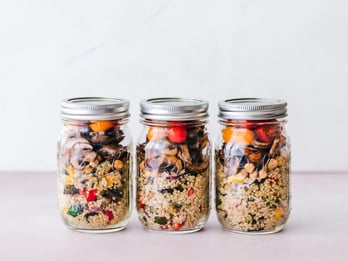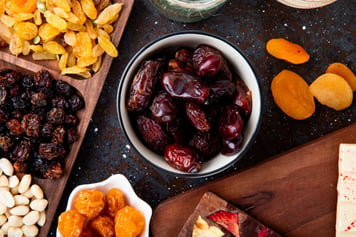While some cook five course meals that could feed an army, or host a potluck where guests bring their favorite dish with them, others keep it light with finger foods, or avoid cooking all together by catering in. We all plan to celebrate the holidays in our own way. More personally, you may find that in the spirit of the holidays, your husband invites over the new neighbors at the last minute, and your daughter begs to have her entire friend group over for a gift-exchange.
It never fails—we only plan to cook for our families of five or so, but it quickly turns into a meal to feed twenty or more. We must always be prepared. No matter how many times we tell ourselves that we will not prepare too much food next year, there is usually an overflow after the holiday gatherings.
So the questions remain: What do we do with all the leftovers? Is it even safe to eat leftovers? How can I return to focus on healthy eating after such a food-focused holiday?
Following are some expert tips and tricks for your leftovers, as well as some quick and healthy meal ideas for your leftovers.
Start with Food Safety.
No one wants to get food poisoning, especially during the holidays. However, leftovers may be your favorite part of this time of year! So, it is best to know a little food safety to ensure that you and your loved ones avoid getting sick and don’t waste those tasty holiday-only staples.
-
Set a timer. While it’s easy to get caught up in the celebration with your family and friends, your food line up might be lingering just a little too long. Make note of when you put your food out, and set a reminder to ensure that you take a few minutes to appropriately store your leftovers one to two hours later
-
Airtight storage. Speaking of storage, storing your foods in airtight containers or bags can help protect foods from potentially harmful bacteria or other unwanted exposures. Properly stored foods can stay fresh for three to four days, and sometimes up to seven days, depending on the ingredients and storage methods.
-
Just toss it. Esther Ellis, MS, RDN, LDN writes that it is best to “throw away perishable foods, such as meat, poultry, eggs and casseroles, left at room temperature longer than two hours and within one hour if it’s warmer than 90 degrees F.” Using this general rule of thumb can be the difference in you celebrating your holidays actively with your loved ones or in bed. Better safe than sorry!
-
See, smell, then taste. It is obvious that if that once tasty dish looks or smells spoiled, it likely isn’t worthy of eating again. By visually observing and smelling the food first, you can help determine if you want to then do a tiny taste test. If it looks and smells normal, you may simply take a tiny taste (about 1/8th of a spoonful) to further determine if your leftovers are okay to eat again. Ellis adds, “You can’t tell if a food is unsafe by taste, smell, or appearance alone.” So for a general rule of thumb, it is always best to default back to the just toss it tip above.
-
Know the thaw. Though we are all possibly guilty of leaving food on the counter to thaw after being in the freezer, the U.S. Department of Agriculture encourages the use of cold water, microwave, or refrigerator. Microwaving leftovers is the fastest method for thawing, while refrigerating takes the longest. Learn more.
As a complex matter, remaining informed on food safety is important. Now let’s get to those ideas for making some equally delicious and healthy meals from your leftovers.
Eating leftovers doesn't have to be boring.
There are many ways to transform your leftovers into creative, healthy dishes. You can make a quesadilla or mini pizza with the kiddos, or throw them in your morning frittata, like this recipe from Love and Lemons. Alternatively, you might be thinking of repurposing the pounds of leftover turkey into quesadillas with cranberry salsa. The sky’s the limit when it comes to making new meals out of your leftovers. Below are some foundational ideas to help you get started.
Smoothies– Whether you are trying to jumpstart your healthy eating again or just want something lighter for your meal, use your leftover fruits or vegetables for a fresh alternative or meal replacement.
Soups- Reusing your baked potatoes for loaded baked potato soup, or some classic turkey vegetable soup with tomatoes, corn, and okra, can be a great option for your leftover veggies and protein.
Salads- A staple healthy meal does not have to be lackluster. Throw on the leftover veggies or fruits (warm or cold) and add a little homemade dressing of balsamic vinegar and olive oil, and enjoy.
Wraps- Pardon the pun, but wrap up your protein and veggies, just like you did those gifts this year. Opt for a low-carb wrap, or use lettuce for a low-calorie alternative.
Main dish and sides- Seems a bit obvious, but if you have some leftover sides like green beans or broccoli, simply pair with a lean protein and you have a quick, healthy meal.
Toppings- Try topping off your morning oatmeal with some nuts and leftover fruit like cranberries, or load up your mashed potatoes with some leftover and frozen veggies together.
Appetizers- Appetizers like meat with dips or Charcuterie boards are easy to put together and require little to no work.
Want some more ideas or recipes with your specific ingredients list, check out this resource for some additional ideas. After reading some of these ideas, we’re sure you can come up with your own healthy versions to use for your holiday leftovers. Have fun being creative in the kitchen!
.png?width=1650&height=1275&name=website%20images%20(30).png)
Table of contents



